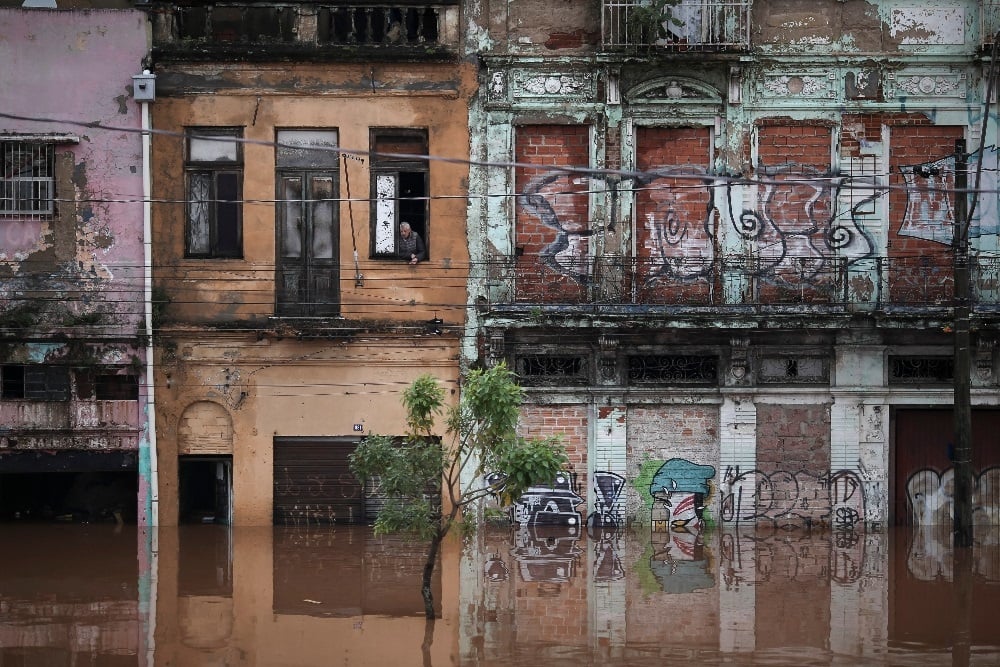
View of a flooded street in the historic center of Porto Alegre, Rio Grande do Sul, Brazil, May 5, 2024. (Anselmo Cunha/AFP)
- At least 66 people have died and more than 80,000 have been forced to flee to the safety of their homes after catastrophic flooding in southern Brazil.
- Authorities rushed to evacuate the affected areas as rescue workers used four-wheel-drive vehicles and even jet skis to navigate through waist-deep water.
- Brazilian President Luiz Inacio Lula da Silva, who visited the area on Thursday, blamed the disaster on climate change.
Authorities in southern Brazil raced against time Sunday to rescue people from severe flooding and landslides that have killed at least 66 people and forced more than 80,000 to flee their homes.
In Porto Alegre, the capital of Rio Grande do Sul state, people stood on rooftops hoping for help as people in canoes and small boats navigated roads that had been turned into rivers.
Civil defense officials say at least 101 people are missing in the latest in a series of devastating weather events to hit the South American megacity.
From the air, Porto Alegre was completely flooded, with roads submerged and the roofs of some houses barely visible.
The Guaiba River, which flows through the city of 1.4 million people, has reached a record height of 5.3 meters, according to local authorities, far surpassing its historic high of 4.76 meters, which had been set since the devastating floods of 1941. exceeded.
Water is still flowing into economically important Porto Alegre and hundreds of other regions, with increasingly dramatic consequences.
Rain fell intermittently on Sunday morning and was expected to continue for another day as flood waters continued to rise.
Read | 'Horrifying' floods in Brazil kill 57, force 70,000 to evacuate their homes
Brazil's Civil Defense Agency said the toll is immeasurable, with tens of thousands of people forced to flee their homes and more than one million people without access to drinking water. Approximately 15,000 people are currently living in evacuation centers.
Rosana Custodio, a 37-year-old nurse, evacuated her flooded home in Porto Alegre with her husband and three children.
“On Thursday night, the water level started rising rapidly,” she told AFP via a WhatsApp message.
she said:
Quickly, we ran outside to find a safer place. But we couldn't walk…my husband put our two kids in a kayak and paddled with bamboo. My son and I swam to the end of the road.
Her family was safe, but “we lost everything we had.”
Authorities rushed to evacuate submerged areas, while rescue workers also used four-wheel-drive vehicles and jet skis to search for people stranded in waist-deep water.
Rio Grande do Sul Governor Eduardo Leite said rebuilding the state, typically one of Brazil's wealthiest, would require a “Marshall Plan” with significant investments.
Paulo Pimenta, a senior public relations official under President Luiz Inácio Lula da Silva, said Sunday would be a key day for the rescue operation.
Bus services to and from the city center were suspended, but long lines of people formed in various locations trying to board buses.
Porto Alegre International Airport suspended all flight operations on Friday for an unspecified period.
Lula posted a video showing a helicopter lowering soldiers onto the roof of a house, and the soldiers using bricks to cut a hole in the roof and rescue the baby, who was wrapped in a blanket.
The speed at which water levels were rising worried many.
Greta Bittencourt, a 32-year-old professional poker player, said: “It was scary because I saw the water level rising at such an incredible rate.”
Governor Leyte said in an Instagram livestream that the situation is “absolutely unprecedented” and the worst in the history of the state, which is known for its agricultural production of soybeans, rice, wheat and corn.
Residential areas were submerged as far as the eye could see, roads were destroyed, and bridges were washed away by the strong currents.
Rescue teams faced a monumental task with the entire town inaccessible.
At least 300 municipalities in Rio Grande do Sul state have been affected by the storm since Monday, local officials said.
Rain also affected the southern state of Santa Catarina.
Lula, who visited the area on Thursday, blamed the disaster on climate change.
Climatologist Francisco Eliseu Aquino told AFP on Friday that the devastating storm was the result of a “disastrous cocktail” of global warming and El Niño.
South America's largest country has recently been hit by a series of extreme weather events, including a cyclone in September that killed at least 31 people.

